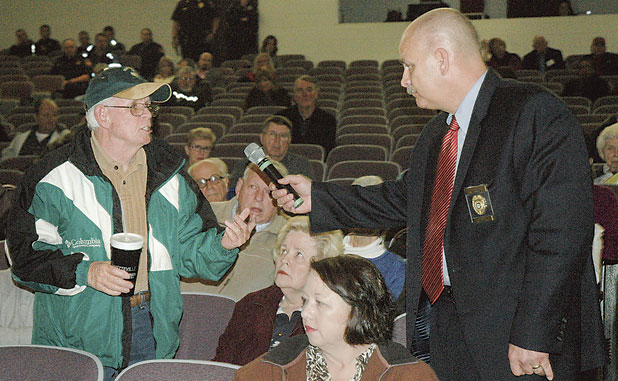Fayetteville police teach citizens when to run, when to hide and when to fight
If you hear gunshots, or see a man with a gun coming toward you, you’ve got three options: Run, hide or fight.
That’s the information nearly 140 people at Sams Auditorium on Jan. 28 received about active shooter scenarios from Fayetteville Police Lt. Mike Whitlow.
“This is to get you thinking about what you would do if it does happen,” Whitlow said at the outset of the meeting.
Whitlow used an active shooter film produced by the city of Houston, Texas, combined with information on the aspects of active shooter incidents that residents would need to know if ever placed in that situation.
Whitlow at the outset noted that while heavily covered by the media, there have been a total of 160 active shooter incidents in the U.S. between 2000-2013.
“That’s 11.5 per year,” Whitlow said. “The odds of that happening here are very, very slim. And, hopefully, we’ll never have one.”
As Whitlow noted, the idea behind holding the active shooter presentation was to give residents the type of information needed to stay as safe as possible if such an event should occur.
“I don’t want you to be paranoid, I just want you to be aware,” Whitlow emphasized before showing the film entitled “Run, Hide, Fight.”
The film, along with Whitlow’s comments, detailed a number of variables within each of the three options when faced with an active shooter situation.
Pertaining to “run,” Whitlow said, “If you can get out, do it. Your first priority is to get out of harm’s way.”
Whitlow cautioned people not to worry about collecting their belongings.
“Evacuate. Help others escape if possible. Prevent others from entering the area once you’re outside. And call 911,” said Whitlow.
If unable to run, the next option is to “hide,” Whitlow said.
The idea is to lock an office or other door and block it to deter the shooter, Whitlow said, reminding the audience to silence cell phones, hide behind large objects and remain silent. Whitlow emphasized getting as low to the ground as possible and to control breathing.
The third option is to ‘fight.”
This is the last resort,” Whitlow said, advising the audience that fighting back requires a complete commitment to do so.
“This is not like TV,” said Whitlow. “Most incidents that end before the cops get there were when the shooter was met with force and was incapacitated or took his own life. If you’re not committed, hide until we get there.”
Whitlow also noted that those at the scene who are armed when police arrive should put their weapon on the ground and put their hands in the air. Though not guilty of wrongdoing, the reason is obvious.
“We just got there and we don’t know who you are,” Whitlow explained. “Also, remain calm and follow instructions. Be prepared to stay for a while because it’s a crime scene and we will need to interview everybody.”
The presentation also included Whitlow answering a number of audience questions.













Leave a Comment
You must be logged in to post a comment.